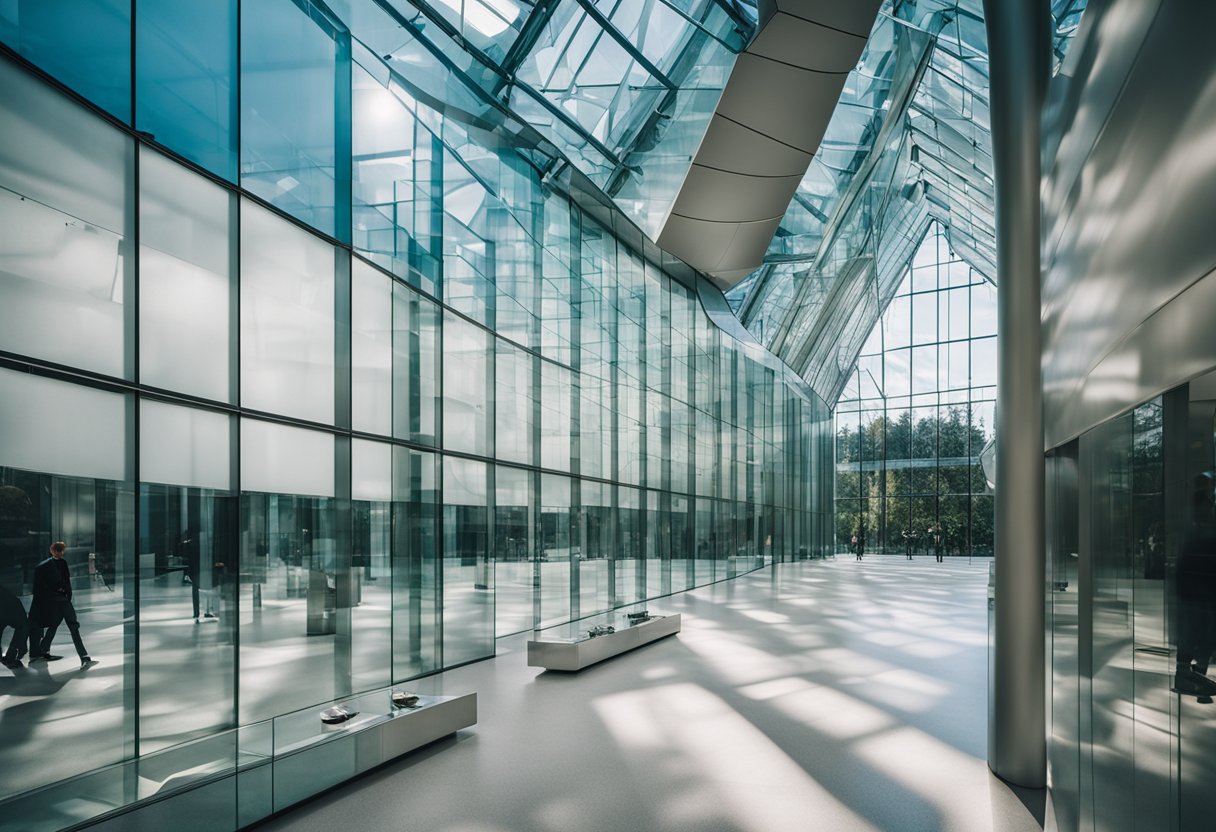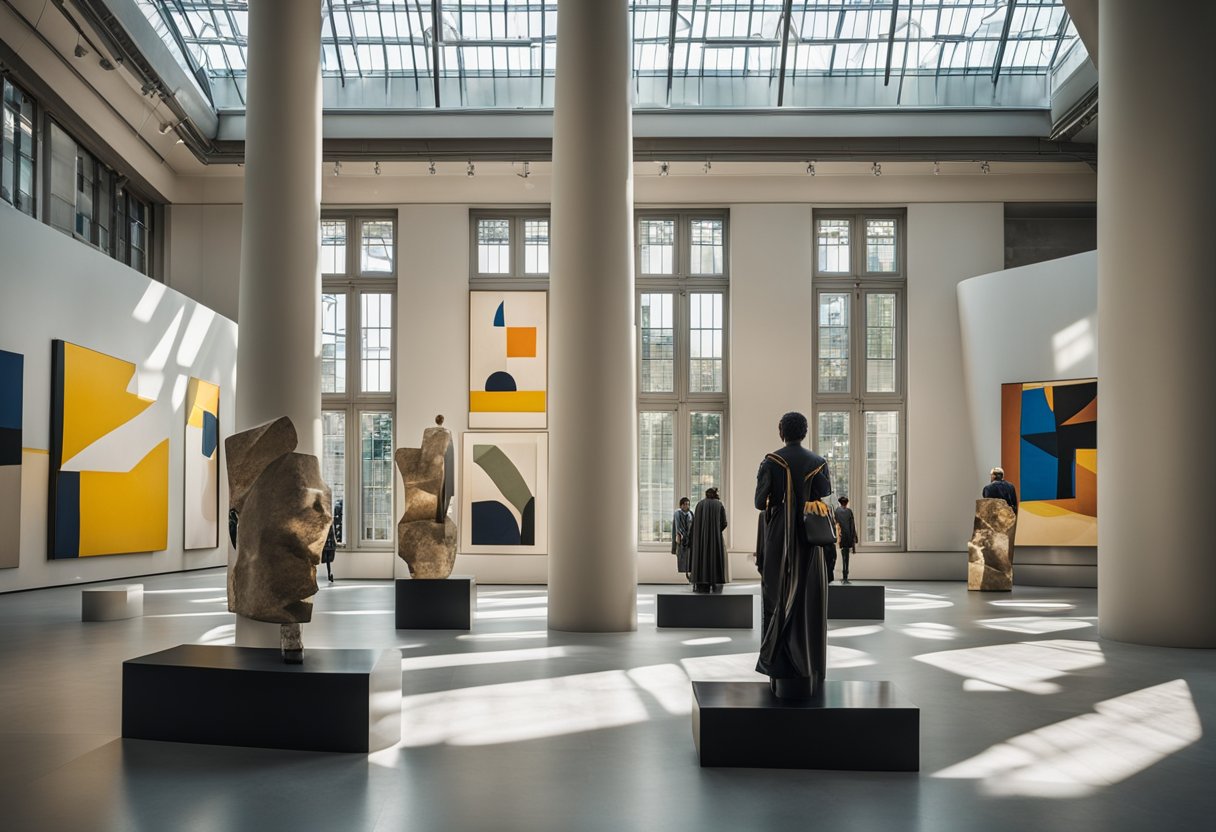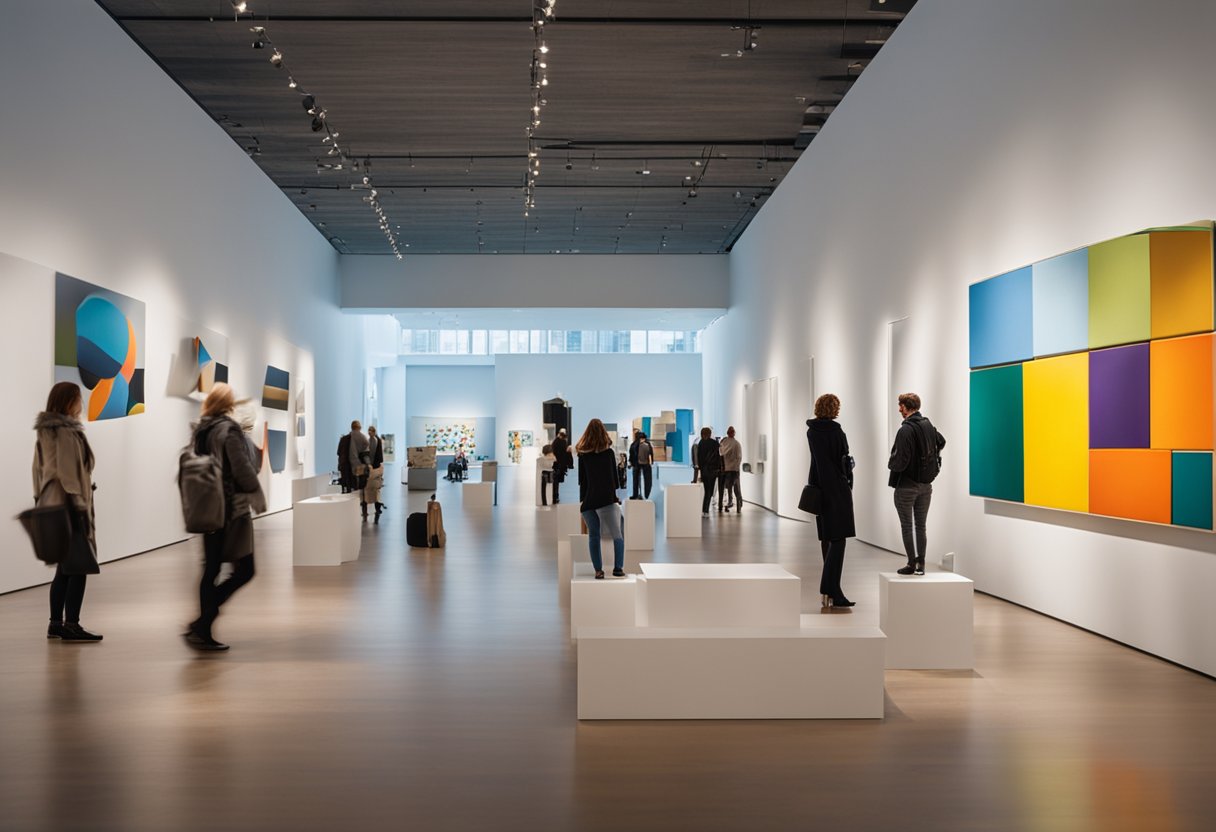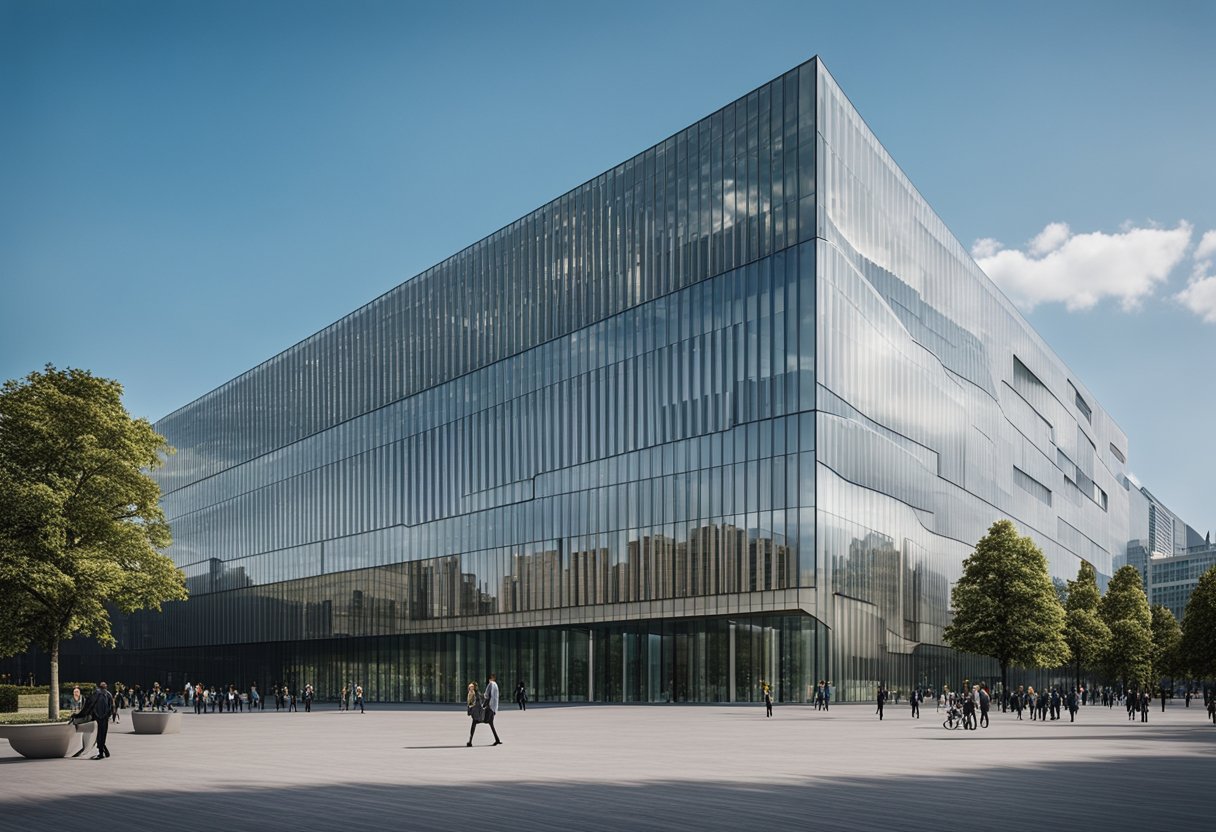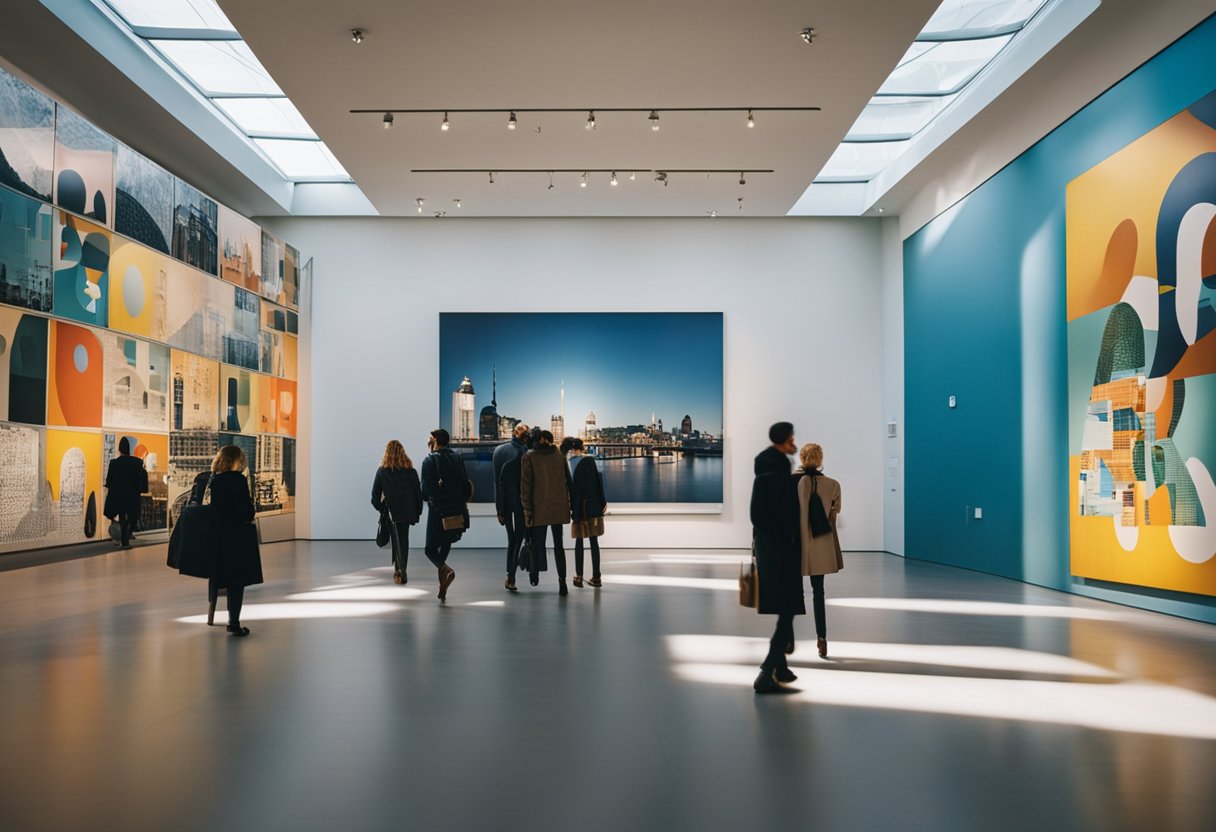Berlin, a vibrant city with a rich historical tapestry, has long been a hub for creativity and culture. It’s no surprise that the city offers an eclectic array of modern art museums, each providing a unique perspective on the artistic movements that have shaped contemporary art. As aficionados of modern creativity, we find ourselves drawn to these institutions, where the spirit of innovation is captured and displayed.
There are many places in the Modern Art Museum Berlin has to offer. In these galleries, we uncover a world where the traditional boundaries of art are continuously challenged and redefined.
Navigating through Berlin’s modern art scene, we encounter the Berlinische Galerie, a temple of modern art, photography, and architecture.
It stands as a testament to the city’s commitment to celebrating art that spans the full spectrum of modern expression. Here, among the works of visionary artists, we experience the pulse of Berlin’s contemporary art narrative.
Our journey through modern art in Berlin takes us from the post-war era to the pulsating present, showcasing a myriad of artworks that range from avant-garde to the sublimely abstract. At venues like the Neue Nationalgalerie, we immerse ourselves in a world where each piece tells a story, each gallery unveils a chapter of history, and together, they compose the grand tapestry of modern art that Berlin proudly displays to the world.
History of Modern Art in Berlin
As we explore the rich tapestry of modern art in Berlin, we find a history marked by innovation, destruction, and reconciliation. Berlin has been at the forefront of avant-garde movements, deeply impacted by global conflicts, and uniquely positioned during the Cold War, offering a distinctive narrative that encompasses various styles and periods—from Expressionism to the East Side Gallery.
Rise of Avant-Garde Movements
In the early 20th century, Berlin emerged as a hub for new art forms, with Expressionism taking center stage. Artists like Ernst Ludwig Kirchner became prominent figures, using bold colors and strokes to convey emotional realities. Groups such as Die Brücke (The Bridge) pioneered this aesthetic, rebelling against traditional art forms and favoring subjective interpretations that would deeply influence modern art.
Impact of the World Wars
The interwar period saw the advent of a new artistic realism, New Objectivity, reflecting the disillusionment post-World War I. However, the rise of the National Socialist regime led to the denouncement of modernist art as “degenerate,” causing many artists to flee or suppress their creative expressions. The aftermath of the Second World War led to widespread destruction of cultural sites, including many pieces of significant art, forever altering Berlin’s artistic landscape.
East Meets West: Art During the Cold War
During the Cold War, Berlin’s art scene became a microcosm for the ideological divide between East and West. On one side, state-controlled art was prevalent, while alternative movements thrived in the West. Following the fall of the Berlin Wall, the East Side Gallery emerged as a symbol of newfound freedom, transforming the remnants of the wall into the world’s largest outdoor gallery—epitomizing the enduring spirit of Berlin’s modern art.
Through these periods, Berlin’s modern art history is not just about the artistic movements or the tumult of global events; it’s also the story of a city’s undying dedication to the expression and evolution of creativity.
Major Modern Art Museums of Berlin
Berlin is home to an impressive array of modern art museums, each housing a vast collection of works that span centuries and various movements in art history. These institutions are not just buildings but cultural beacons that showcase the depth and diversity of modern art.
Nationalgalerie and Its Collections
The Nationalgalerie stands as a pivotal institution within Berlin’s art landscape, encompassing several key locations that cater to different eras and styles of art. Our offerings include a variety of collections that reflect the evolution of art from the 19th century to the present day. The Nationalgalerie’s extensive array of works ensures that every visit is as enlightening as it is inspiring.
Berlinische Galerie
As a museum for modern art, photography, and architecture, the Berlinische Galerie holds a distinctive position in the constellation of Berlin’s museums. With a focus on art from Berlin dating from 1870 to the present day, our exhibitions provide a comprehensive showcase of the city’s local art scene.
Hamburger Bahnhof
The Hamburger Bahnhof museum represents a significant chapter in contemporary art, with a majestic building that once served as a historical railway station. Our exhibition space features a dynamic and expansive collection of contemporary works, echoing the cutting-edge creative spirit of the city.
Museum Island and Alte Nationalgalerie
Set in the heart of Berlin, the Museum Island is a UNESCO World Heritage Site that is home to the Alte Nationalgalerie. Here, we celebrate 19th-century art within an architectural wonder, showcasing neoclassical, romantic, Biedermeier, impressionist, and early modernist artworks.
Neue Nationalgalerie and Kulturforum
The Neue Nationalgalerie, located at the Kulturforum, is a landmark of contemporary art. Our space is dedicated to artists of the 20th century, with a particular emphasis on pieces from the Classical Modernism era. Designed by Mies van der Rohe, the museum itself is a masterpiece of modern architecture.
Contemporary Art and Exhibitions
Berlin’s art scene is a dynamic canvas where the contemporary pulse is palpable through various mediums such as photography, sculptures, and paintings. Our tour through the city’s cultural heart takes us to prominent galleries and exhibitions that define Berlin’s modern aesthetic. We will explore key venues from the vibrant Kreuzberg district to the prestigious spaces that house both special and temporary exhibitions.
Berlin Gallery Scene
We find Kreuzberg to be a hub of creativity, showcasing an array of contemporary art. The Contemporary Fine Arts gallery stands as a beacon for cutting-edge works that span diverse artistic expressions. This district sets the stage for Berlin’s status as a sanctuary for artists and art aficionados alike.
Sammlung Boros and Bunker Exhibitions
Sammlung Boros is a collection housed in a converted WWII bunker. Here, we encounter a fusion of historical architecture and contemporary creations. The bunker exhibitions feature an impressive private collection that includes a multitude of contemporary artworks, highlighting the innovative spirit of Berlin’s art world.
KW Institute for Contemporary Art
Situated in the heart of Berlin, the KW Institute for Contemporary Art is a pivotal institution where new artistic trends and thought-provoking ideas converge. It offers a platform for emerging artists and is instrumental in launching the careers of numerous now-renowned figures in the art community.
Special and Temporary Exhibitions
In Berlin, special and temporary exhibitions provide us the chance to witness rare and fleeting moments of artistic brilliance. Renowned museums and galleries adapt their spaces to host these unique showcases, bringing together celebrated international artists and the city’s thriving local talent.
Architectural Significance
In discussing the architectural significance of modern art museums in Berlin, we must notably mention the influence of the Bauhaus Movement as well as the meticulous work involved in restoration and modern expansion efforts. We take pride in acknowledging the city’s innovative museum designs that powerfully embody both the history and future of architecture.
Bauhaus Movement and Modernism
Berlin’s museum landscape serves as a testament to the enduring legacy of the Bauhaus Movement. Architects like Mies van der Rohe have left an indelible mark on the city with their minimalist design philosophies. Van der Rohe’s Neue Nationalgalerie stands as a paragon of 20th-century modernism, underscoring the movement’s principles with its open floor plans and industrial materials. It exemplifies how functionality and aesthetic simplicity became integrated into Berlin’s cultural institutions.
Restoration and Modern Expansion
The process of restoration bridges Berlin’s rich past with contemporary innovation. A poignant example is the recent refurbishment of the Neue Nationalgalerie, overseen by David Chipperfield Architects. Their delicate approach to the restoration work respected van der Rohe’s original specifications while integrating state-of-the-art materials and technology. This not only revitalized the museum’s presence but also broadened its capacity to house modern art collections.
Innovative Museum Designs
In Berlin, the designs of modern art museums continuously push the envelope, leveraging new architectural concepts without sacrificing historical integrity. Materials like glass, steel, and concrete are reenvisioned to create fluid spaces that complement the dynamic nature of modern art. Our city’s museums exemplify how innovative design can shape the experience of art, immersing visitors in environments that both challenge and celebrate modern artistic expressions.
Berlin’s Art Culture and Influence
Berlin’s vibrant art culture is both a historic chronicle and a beacon of influence. Our city stands as an unparalleled hub of creative exchange, where the legacy of the Berlin Wall and the collaborative efforts across continents shape its cultural landscape.
Impact of The Berlin Wall on Cultural Expression
The Berlin Wall, once a symbol of division, has become an emblem of artistic freedom and resistance. Berlin State Museums often reflect on this era, showcasing art that encapsulates the tension and release that followed the Wall’s fall. Murals and graffiti that once adorned the concrete barrier are preserved parts of our city’s history, telling stories of a culture that thrived in adversity.
Global Influence and Cultural Exchange
Our city extends its reach well beyond Europe, engaging in a rich cultural exchange with Asia, Africa, and the rest of the world. This cross-pollination has enriched Berlin’s cultural fabric, evident in exhibitions at venues like the Neue Nationalgalerie, where diverse perspectives intertwine with local narratives. It’s a two-way street, with Berlin influencing global art trends while also absorbing international techniques and ideas.
The Role of Berlin in the Contemporary Art World
In the contemporary art scene, Berlin occupies a unique position. We are custodians of innovation, often hosting groundbreaking exhibitions that spotlight avant-garde ideas and emerging talent. Contemporary art spaces, like those highlighted by the Berlinische Galerie and in Auguststraße, are pillars of this role, celebrating Berlin’s enduring impact on the art world. This dynamic environment fosters a haven for creators and connoisseurs alike, continually redefining the boundaries of modern art.
Notable Artists and Works
In this exploration of Berlin’s modern art scene, we discover the influential movements and artists whose work has shaped the landscape of contemporary fine arts. We delve into the contributions of German Expressionists, the treasured works housed in Berlin collections, and the vibrant creativity of emerging avant-garde artists.
German Expressionists and Their Legacy
German Expressionism left an indelible mark on the art world, with Ernst Ludwig Kirchner and Emil Nolde spearheading this revolutionary movement. Their bold use of color and form paved the way for later developments in abstract and surrealist art. In Berlin, Max Beckmann and Käthe Kollwitz are celebrated for their evocative and intense portrayals of the human condition. The National Gallery serves as a custodian for these seminal works, ensuring their legacy endures.
Modern Masters in Berlin Collections
Berlin’s art museums are sanctuaries for masterpieces by the likes of Wassily Kandinsky and Paul Klee, whose explorations in color theory and abstract painting are cornerstones of modern art. Works by Pablo Picasso can be seen at the Gemäldegalerie, underscoring the city’s status as a haven for internationally renowned art. The Neue Nationalgalerie further cements this with its extensive collection, showcasing the progressiveness and the breadth of modern art.
Emerging Artists and Cutting-Edge Art
Our city’s galleries and exhibitions continuously feature cutting-edge art that propels Berlin’s reputation as a hotspot for contemporary creativity. Newer voices, such as those highlighted at Berlinische Galerie, engage with radical mediums and thought-provoking themes. Artists like Lotte Laserstein and Hannah Höch play crucial roles in nurturing this innovative spirit, pushing the boundaries of what art can be and how it can reflect our ever-changing society.
Visitor Information
When visiting the modern art museums in Berlin, we ensure you have access to all the essential information, from ticketing options to the amenities provided. We aim to make your experience enjoyable and convenient.
Tickets and Berlin Museum Pass
Tickets to individual museums can be purchased at the entrance. However, for extensive access to numerous exhibitions, we recommend the Berlin Museum Pass, which provides entry to over 30 museums for three consecutive days. Please note that some special exhibitions may require separate tickets. For those interested in the Neue Nationalgalerie, visiting on Thursdays from 4 p.m. to 8 p.m., you can enjoy free entry to the museum including special exhibitions.
Amenities: Shops, Cafés, Libraries
Our museums are furnished with a variety of amenities to enhance your visit. Discover a selection of art books, souvenirs, and unique gifts in our museum shops. Take a moment to relax and reflect on the exhibitions in our cafés, where you can enjoy a coffee or a light snack. For research and reading, our libraries are a treasure trove of art literature.
Accessibility and Visitor Services
We commit to making art accessible to everyone. Our museums offer services for visitors with disabilities, ensuring a comfortable and enriching experience for all. Please refer to our privacy policy for details on how we handle your data with consent, ensuring your visit is not only pleasurable but also respectful of your privacy. If you require special assistance or have queries regarding our accessibility options, do not hesitate to contact our visitor services for more information.
Art Beyond the Museums
Berlin’s vibrant cultural scene extends well beyond the confines of traditional gallery spaces. We find that our city’s street corners, abandoned buildings, and public parks are just as influential in the art world. Here, modern art intertwines with historical narratives and urban landscapes, offering a rich, immersive experience for all who encounter it.
Street Art and Urban Culture
Berlin’s East Side Gallery is one of the largest open-air galleries in the world, showcasing over 100 murals painted on remnants of the Berlin Wall. This iconic spot stands as a testament to freedom and creativity, and it’s where you can witness the transformative power of street art firsthand. Our city’s streets serve as canvases reflecting our complex history and contemporary socio-political commentary, with neighborhoods like Kreuzberg and Friedrichshain leading as hotbeds for vibrant urban art.
Kunstraum Kreuzberg/Bethanien and Alternative Spaces
At Kunstraum Kreuzberg/Bethanien, we explore the intersection of art with other societal elements. Situated in a former hospital, this dynamic space showcases contemporary art that delves into themes of politics, culture, and identity. Alternative art spaces here play a crucial role in our diverse art scene, often pushing the boundaries of expression and hosting innovative exhibitions that challenge the status quo.
Sculpture Gardens and Public Exhibitions
Berlin also offers numerous public spaces where art and nature merge. The Sculpture Garden at Kulturforum is a place where we can enjoy sculptures by artists from different periods, giving us insight into the evolution of three-dimensional art. Throughout the city, public exhibitions reveal the importance of accessibility in art, making sure that these creations are woven into our everyday life and reachable by all who walk our streets.
